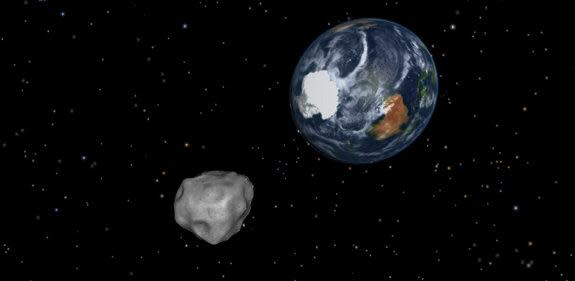 Science and Weather
Science and WeatherRecord-breaking asteroid flyby highlights the dangers of impact
If you're on your cellphone Friday afternoon at around 2:24 p.m. EST (19:24 GMT) and your call suddenly gets dropped, you might do better cursing the heavens than cursing your service provider.
That's because, right about that time, 2012 DA14 — a roughly 50 metre-wide hunk of rock, weighing in at around 200,000 metric tons — will be whizzing by the Earth. At its closest pass, it will be only 27,700 kilometres from the surface, which is still pretty far away — so there's no chance of it impacting with the Earth — but it will be flying underneath the orbit of our geosynchronous weather and communication satellites.
[ Related: What would happen if asteroid 2012 DA14 hit Earth? ]
The asteroid's tracking information has been made available to everyone who has a satellite in orbit, so that they can ensure that the asteroid doesn't upset their many customers. However, with the amount of space junk that's floating around above our heads, who knows what this asteroid may plow through, sending shrapnel and debris flying everywhere.
Check out this very cool video animation of the asteroid's flyby:
Even though 2012 DA14 isn't going to hit Earth (either on Friday or anytime in the foreseeable future), this is a record-breaking pass, as it is the closest approach of any asteroid of 2012 DA14's size. That fact is serving to raise awareness of just how dangerous the space around our home really is. As it's name implies, 2012 DA14 was discovered just last year, but can we really say that we'd have been able to do anything about it if it really was going to slam into the Earth, even with nearly a year to work something out?
Fortunately there is no chance of 2012 DA14 hitting us, but scientists are still going to be watching the asteroid closely as it flies by, and not just for the photo opportunities.
One aspect of an asteroid's motion that is very important for tracking it, is its rotation. This is due to what's known as the 'Yarkovsky Effect'. As an object orbits the Sun, it absorbs energy from the Sun's rays, and it radiates the energy back into space as heat. If the object is rotating as it orbits the Sun, it radiates this heat into space in all directions, rather than just back towards the Sun, but its rotation causes a stronger force to be exerted in the 'afternoon' and 'evening' periods and a weaker force to be exerted in the 'pre-dawn' and 'morning' periods.
This difference in the strength of the force causes a shift in the object's orbit that is very tiny, but also very consistent, so it is essential to know the extent of the Yarkovsky Effect on any object in order to know its exact orbit. Therefore, as it flies by, astronomers will be keeping a close eye on 2012 DA14's rotation.
[ More Geekquinox: SETI wants your help in naming Pluto’s new moons ]
If you want to see the asteroid make its pass by the Earth on Friday, you can watch it on one of a few sites:
• The Clay Center Observatory, in Brookline, Massachusetts, will be showing the flyby on their UStream channel (click here).
• The Virtual Telescope Project 2.0 will be showing the event on the WebTV channel (click here).
• The Slooh Space Camera will be likely streaming the usual free live event they put on for all of these kinds of astronomical events (click here).
This is definitely one for the history books, so don't miss out on seeing it!
(Image credits: NASA-JPL/wiki creative commons. Video credit: Analytical Graphics, Inc)
Geek out with the latest in science and weather.
Follow @ygeekquinox on Twitter!




